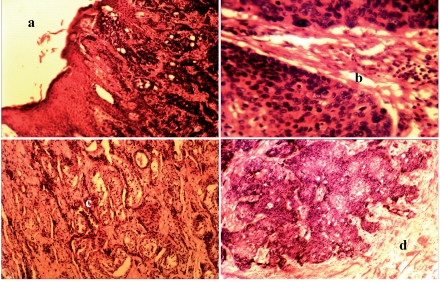Abstract
Squamous cell carcinoma of the scrotum is rare and to the best of our knowledge has never been reported from Nigeria. We report on a case thought to be occupation-related in a 42-year old Nigerian taxi driver who had previously been an automobile mechanic and later a long-haul truck driver. He presented with a stage D disease and only palliation was feasible.
Key words: cancer of the scrotum, occupational cancer, automobile mechanic, used engine oil.
Case Report
A 42-year old taxi driver who had been a car mechanic for four years 25 years earlier presented in 2007 with a ten-year history of a small pruritic painless nodule on his ventral scrotal surface which had ulcerated but failed to heal. He infrequently washed his work-outfit while an auto-mechanic and admitted to its frequent soiling, sometimes up to his underwear, with used engine oil while at work. He took a bath at the close of work each day; however, his personal hygiene outside the workplace was good.
On examination he was pale, had a foulsmelling, grotesque, fungating, ulcero-proliferative mass with rolled edges which involved the whole scrotum and proximal third of the penile shaft, extending 5 cm to the right thigh antero-medially and 3 cm of the anal verge.
The scrotum was fixed to the pubis. There were bilateral inguinal lymphadenopathy involving both the vertical and horizontal chains. He looked otherwise well nourished and was ambulant. He was also rather depressed emotionally.
Ultrasonography revealed a hepatomegaly and para-aortic lymphadenopathy, the largest 2.8 cm in diameter. His general condition was optimized and biopsy confirmed the diagnosis. He had palliative scrotectomy with bilateral orchidectomy and subsequently cisplatinumbased combination chemotherapy, after he had been counseled and informed consent obtained. Histopathological review showed scrotal squamous cell carcinoma with testicular involvement (Figure 1). He succumbed to the disease after seven months.
Figure 1.
a, b, c, d. Histology of the various sections of the tumor; (a) Normal skin and contiguous areas the well differentiated squamous cell carcinoma invading the surrounding deeper tissue; (b) High magnification of the malignant squamous cells; (c) Remnants of the testicular tubules being invaded by the tumor; (d) The malignant squamous cells invading the deeper testes.
Discussion
The scrotum is a seven-layer pouch which invests the testes, testicular adnexae, and distal spermatic cord. The scrotal lymphatics drain into the corresponding superficial inguinal nodes. Anastomoses exist between the lymphatics of the contralateral network across the median raphe. Tumors have been reported that arise out of virtually any of the components of the scrotal wall.1
Squamous cell carcinoma of the scrotum is now exceedingly rare. It was the first malignancy linked to occupational exposure.1–2 Previously, it most commonly resulted from exposure to environmental carcinogens such as chimney soot, tars, paraffin, and some petroleum products. Currently most cases result from poor hygiene and chronic inflammation.3
Used engine oils have elevated polycyclic aromatic hydrocarbons which tend to be greater for petrol engines than for diesel engines. Prolonged and repeated contact with such oils can cause skin and scrotal cancer. Car mechanics are at potential risk from used engine oil.4
Best occupational health practices are invaluable at the workplace for those at risk to minimize exposure. Prognosis correlates with extent of nodal involvement with virtually no survivors if iliac nodes are involved.3,5 Ability to achieve a negative margin at the time of initial surgery is an important prognostic factor as adjunctive therapy such as radiotherapy or chemotherapy or both has not proven useful.1 In conclusion, the index patient presented very late when even surgery, chemotherapy and radiotherapy could not possibly offer any meaningful improvement in terms of outcome. We believe this case will raise the awareness in our environment of the existence of this disease and improve the index of suspicion among practicing surgeons and oncologists.
References
- 1.Rowland RG, Herman JR. Tumors and Infectious Diseases of the Testis, Epididymis, and Scrotum. In: Gillenwater JY, Grayhack JT, Howards SS, Mitchell ME, editors. Adult and Pediatric Urology. Philadelphia: Lippincott, Williams and Wilkins; 2002. [Google Scholar]
- 2.Waldron HA. A brief history of scrotal cancer. Br J Ind Med. 1983;40:390–401. doi: 10.1136/oem.40.4.390. [DOI] [PMC free article] [PubMed] [Google Scholar]
- 3.Presti JC., Jr. Genital Tumors. In: Tanagho EA, McAnich JW, editors. Smith's General Urology. New York: Mc Graw Hill; 2008. pp. 375–87. [Google Scholar]
- 4.Health and Safety Factsheet — No. 12 (internet) Wyre Borough Council; Lancashire U.K.: 2002. [(Cited 5th July, 2008)]. Available from: http:// www.wyrebc.gov.uk. [Google Scholar]
- 5.Ray B, Whitmore WF., Jr. Experience with Carcinoma of the Scrotum. J Urol. 1977;117:741–5. doi: 10.1016/s0022-5347(17)58608-5. [DOI] [PubMed] [Google Scholar]



